Wikipedia:Picture of the day/January 2018
|
Featured picture tools: |
These featured pictures, as scheduled below, appeared as the picture of the day (POTD) on the English Wikipedia's Main Page in January 2018. Individual sections for each day on this page can be linked to with the day number as the anchor name (e.g. [[Wikipedia:Picture of the day/January 2018#1]] for January 1).
You can add an automatically updating POTD template to your user page using {{Pic of the day}} (version with blurb) or {{POTD}} (version without blurb). For instructions on how to make custom POTD layouts, see Wikipedia:Picture of the day.
January 1

|
A scudo coin from the Papal States, dated 1689, which depicts Pope Alexander VIII on its obverse and Saints Peter and Paul on its reverse. The term scudo, derived from the Latin scutum ("shield"), was used in Italy and the Papal states since the 16th century to refer to large coins. The currency fell out of use in the 19th century. Coin: Antonio Travani, Papal Mint for the Papal States; image: National Numismatic Collection
Recently featured:
|
January 2

|
Mehmed IV (1642–1693) was the Sultan of the Ottoman Empire from 1648 to 1687. He came to the throne at the age of six, and went on to become the second longest reigning sultan in Ottoman history. During his middle years, he oversaw the revival of the empire's fortunes associated with the Köprülü era. Mehmed was known by contemporaries as a particularly pious ruler, and was referred to as gazi, or "holy warrior" for his role in the empire's many conquests. In 1687, after being overthrown, Mehmed retired to Edirne, where he resided until his death. Painting: Unknown
Recently featured:
|
January 3

|
Brompton Oratory is a large neo-classical Roman Catholic church in Brompton, London. Dedicated to the Immaculate Heart of Mary and designed by Herbert Gribble, it was completed in 1884 and remained the largest Roman Catholic church in London until the opening of Westminster Cathedral. It was designated a Grade II* listed building in 1969. Photograph: David Iliff
Recently featured:
|
January 4
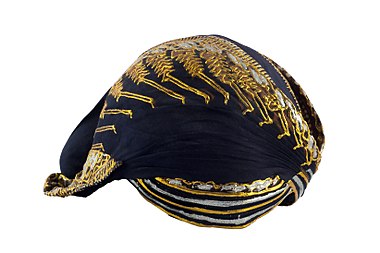
|
A ngayogyakarta-style blangkon used by the Javanese people of Yogyakarta, Indonesia. Such traditional Javanese headdresses are worn by men and made using batik fabric. Aside from Yogyakarta, there are also styles from the Surakarta, Banyumas, and Kedu regions. Photograph: Chris Woodrich
Recently featured:
|
January 5

|
A female limosa harlequin frog (Atelopus limosus) in Panama. This endangered species of toad in the family Bufonidae inhabits stream banks in tropical moist lowland forests and rivers of the Chagres watershed. It is found in two colour forms, one in lowlands and one in uplands. Photograph: Brian Gratwicke
Recently featured:
|
January 6

|
When Will You Marry? is an oil painting from 1892 by the French Post-Impressionist artist Paul Gauguin. Completed during his sojourn in Tahiti, it depicts two Tahitian women—one dressed in traditional attire, the other in Western clothing—sitting in a field. The front figure's tiare flower, as well as the inscription "NAFEA Faa ipoipo" ('When will you marry?') at bottom right, imply that she is looking for a husband. On loan to the Kunstmuseum in Basel, Switzerland, for nearly a half-century, it was sold privately in February 2015 for close to US $210 million, one of the highest prices ever for a work of art. Painting: Paul Gauguin
Recently featured:
|
January 7

|
The cover of a c. 1855 vocal score for La traviata, an opera in three acts by Giuseppe Verdi set to a libretto in Italian by Francesco Maria Piave. Based on La Dame aux Camélias (1852), a play adapted from the novel by Alexandre Dumas, fils, it follows the ill-fated romance of Violetta, a courtesan, and Alfredo, a young bourgeois man. It premiered in 1853 at La Fenice in Venice, and has become one of the world's most frequently performed operas. Illustration: Leopoldo Ratt; restoration: Adam Cuerden
Recently featured:
|
January 8

|
Jaffa Clock Tower is a clock tower on Yefet Street at the northern entrance of Jaffa, an ancient city now part of Tel Aviv, Israel. The tower, which was constructed by the Ottoman Empire between 1900 and 1903, is made of limestone. It incorporates two clocks, as well as a plaque commemorating the Israelis killed in the battle for the town in the 1948 Arab–Israeli War. Photograph: Andrew Shiva
Recently featured:
|
January 9
Subpage 1

|
Chapel of King's College London is a Grade I listed 19th century chapel located in the Strand Campus of King's College London, London, England. Originally designed by Sir Robert Smirke in 1831, the Renaissance Revival chapel seen today was redesigned by the Victorian Gothic architect Sir George Gilbert Scott in 1864. Shown here is a view of the interior, facing the altar. Photograph: David Iliff
Recently featured:
|
Subpage 2

|
Chapel of King's College London is a Grade I listed 19th century chapel located in the Strand Campus of King's College London, London, England. Originally designed by Sir Robert Smirke in 1831, the Renaissance Revival chapel seen today was redesigned by the prominent Victorian Gothic architect Sir George Gilbert Scott in 1864. Shown here is a view of the interior, facing the entrance and organ. Photograph: David Iliff
Recently featured:
|
January 10
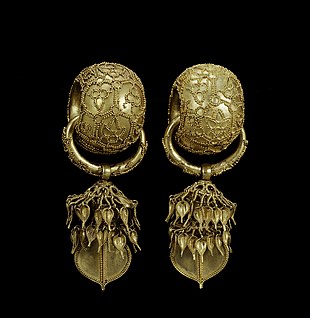
|
Golden earrings found in tombs from the Silla Kingdom, designated National Treasure No. 90 of South Korea in 1962. Earrings are pieces of jewellery attached to the ear via a piercing in the ear, or else clipped onto the ear, generally the earlobe in either case. They may be made of any number of materials, including metal, plastic, glass, precious stone, beads, wood, and bone. Earrings are worn by both sexes, although more common among women, and have been used by different civilizations in different times. Photograph: National Museum of Korea
Recently featured:
|
January 11

|
An Emirates-owned Airbus A380 taking off at Munich Airport. The Dubai-based airline owns and operates 244 aircraft, including 101 Airbus A380-800s and 130 Boeing 777-300ERs, making it the largest operator of these models. It has 202 aircraft on order, including more than a hundred Boeing 777-9s. Photograph: Julian Herzog
Recently featured:
|
January 12

|
|
The flight into Egypt is a biblical event described in the Gospel of Matthew (Matthew 2:13–23). Soon after the visit by the Magi, who had learned that King Herod intended to kill the infants of that area, an angel appeared to Joseph in a dream to tell him to flee to Egypt with Mary and infant son Jesus. The depiction here is part of an altarpiece by the Italian painter Gentile da Fabriano. Painting: Gentile da Fabriano; photograph: Petar Milošević
Recently featured:
|
January 13

|
Members of the United States Army's 24th Infantry Division with an M24 Chaffee along the Nakdong River front, part of the Pusan Perimeter, in 1950. During the Korean War, the Chaffee fared poorly against the T-34 medium tanks used by North Korean forces, which were better armed, better armored, and better crewed. As the war continued it was therefore used primarily in a reconnaissance role, with fighting handled by heavier, more capable tanks such as the M4 Sherman, M26 Pershing, and M46 Patton. Photograph: Sgt. Riley, United States Army
Recently featured:
|
January 14

|
Interior with Portraits is an 1865 genre scene painted by American artist Thomas Le Clear, commissioned by Franklin Sidway. It features Sidway's siblings, James and Parnell, posing for a photograph in an artist's studio. The children were painted posthumously based on family daguerreotypes, and the painting has been read as representing the tension between its medium and the emergent medium of photography. Interior with Portraits is held by the Smithsonian American Art Museum in Washington, D.C. Painting: Thomas Le Clear
Recently featured:
|
January 15

|
Kadavar are a rock band from Berlin, Germany, founded in 2010. Their retro sound, incorporating psychedelic rock and stoner rock, has been compared to bands of the 1970s hard rock/heavy metal era. Kadavar currently consists of three members: guitarist and lead vocalist Christoph "Lupus" Lindemann, drummer Christoph "Tiger" Bartelt, and bassist Simon "Dragon" Bouteloup. Photograph: Henry W. Laurisch
Recently featured:
|
January 16

|
Chrysopa is a genus of green lacewings in the neuropteran family Chrysopidae. Members of it and Chrysoperla are common in much of North America, Europe and Asia. They share similar characteristics and some species have been moved from one genus to the other and back again. Their larvae are predatory and feed on aphids; as such, members of Chrysopa have been used in biological pest control. Photograph: Joaquim Alves Gaspar
Recently featured:
|
January 17

|
Michelle Obama is an American lawyer and writer who was First Lady of the United States from 2009 to 2017. Raised on the South Side of Chicago, Illinois, Obama spent her early legal career working at the law firm Sidley Austin, where she met her husband Barack Obama, before taking positions at the University of Chicago and University of Chicago Medical Center. Obama campaigned for her husband's presidential bid throughout 2007 and 2008, delivering a keynote address at the 2008 Democratic National Convention. When Barack Obama was elected the 44th President of the United States, Michelle Obama became the first African-American First Lady. In this position, she advocated for poverty awareness, nutrition, physical activity and healthy eating. Photograph: Chuck Kennedy
Recently featured:
|
January 18

|
The Wikipedia blackout was a 24-hour period in which access to all articles on the English Wikipedia, barring those on the protested Stop Online Piracy Act and PROTECT IP Act, was suppressed. From January 18–19, 2012, visitors to the website saw only a protest message and the phrase "Imagine a world without free knowledge." It is estimated in excess of 160 million people viewed the banner, which was one of numerous protest actions undertaken at the time. The political environment regarding both bills shifted significantly following the protests, and both were removed from further voting. Image: Wikipedia
Recently featured:
|
January 19

|
Waiting is a pastel on paper by the French Impressionist Edgar Degas, completed between 1880 and 1882. Part of a series of pastels, paintings, mixed media drawings and sculptures of ballerinas, it depicts one accompanied by her chaperone, bent over ostensibly to massage her foot but with body language indicating anticipation. The work, which is jointly owned by the Norton Simon Art Foundation, Pasadena, and the J. Paul Getty Museum, Los Angeles, has been read as emphasizing the brevity of a ballerina's career and the stress they undergo to obtain fleeting moments of elegance. Painting: Edgar Degas
Recently featured:
|
January 20

|
A portrait of a cheetah at Whipsnade Zoo in Bedfordshire. Cheetahs have small and streamlined heads. Their ears are small, short, and rounded, marked by black patches on the back and tawny edges. Their high-set eyes have round pupils, while their whiskers are fine and inconspicuous. Their faces have unique "tear streak" markings that may serve to reduce glare or define facial expressions. Photograph: William Warby
Recently featured:
|
January 21
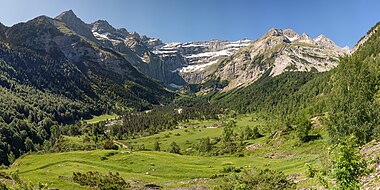
|
The Cirque de Gavarnie is a cirque in the central Pyrenees, in south-western France. It was described by Victor Hugo as "the Colosseum of nature" due to its enormous size, and its horseshoe shape resembling that of an amphitheatre. Formed by repeated cycles of glacial scraping over millions of years, the cirque is surrounded by rock walls that can be as high as 1,500 metres (4,900 ft) above its floor. Major features of the cirque are La Brèche de Roland and Gavarnie Falls. Photograph: Benh Lieu Song
Recently featured:
|
January 22

|
A 14th-century Korean hanging scroll in gold and color on silk depicting Kṣitigarbha, a bodhisattva primarily revered in East Asian Buddhism. He is usually shown as a Buddhist monk with a halo around his shaved head, a staff to force open the gates of hell, and a wish-fulfilling jewel to light up the darkness. In East Asian Buddhism, Kṣitigarbha is known for his vow to take responsibility for the instruction of all beings in the six worlds between the death of Gautama Buddha and the rise of Maitreya, as well as his vow not to achieve Buddhahood until all hells are emptied. He is therefore often regarded as the bodhisattva of hell-beings. Painting: Unknown (image courtesy of the Metropolitan Museum of Art)
Recently featured:
|
January 23

|
Allegory of Vanity, a vanitas completed by Antonio de Pereda between 1632 and 1636. Works in this category of symbolic art, especially associated with still life paintings of 16th- and 17th-century Flanders and the Netherlands, refer to the traditional Christian view of earthly life and the worthless nature of all earthly goods and pursuits. The Latin noun vanĭtās means "emptiness" and derives its prominence from Ecclesiastes. Common symbols in vanitas include skulls, rotten fruit; bubbles; smoke, watches, hourglasses, and musical instruments. Painting: Antonio de Pereda
Recently featured:
|
January 24

|
A 40 shilling note from Connecticut Colony, the English colony that became the U.S. state of Connecticut. The Connecticut pound was introduced in 1709 to replace the British pound. Three series of paper money – known as "Old Tenor", "New Tenor", and "Lawful Money" – were issued before the pound was discontinued in favor of the United States dollar in 1793. Banknote: Connecticut Colony (image courtesy of the National Numismatic Collection)
Recently featured:
|
January 25
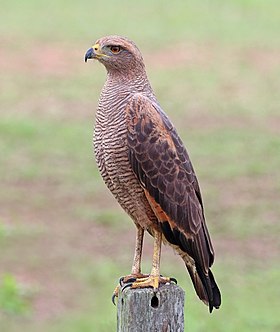
|
A savanna hawk (Buteogallus meridionalis) from the Brazilian Pantanal. This species of large raptors is found in open savanna and swamp in Central and South America. It feeds on small mammals, lizards, snakes, crabs, and large insects. Photograph: Charles J. Sharp
Recently featured:
|
January 26

|
The Quai Saint-Michel and Notre-Dame is a 1901 oil painting on canvas by the French artist Maximilien Luce. Luce was part of the Neo-Impressionist movement between 1887 and 1897 and used the technique of employing separate dabs of colour for the painting, one of ten he undertook of Notre-Dame de Paris. The Musée d'Orsay in Paris, which holds the image, note that it was completed as Luce was moving from his Neo-Impressionist period to his later Pointillist period. Painting: Maximilien Luce
Recently featured:
|
January 27
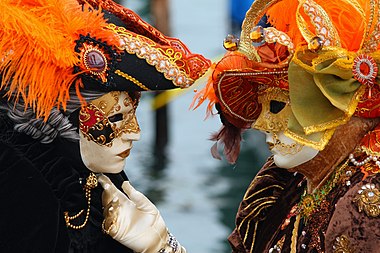
|
Masked lovers during the 2010 Carnival of Venice, an annual festival held in Venice, Italy, which ends on Shrove Tuesday. Although it traces its roots to the 12th century, the current festival only began in 1979, when the Italian government used the Carnival as the centerpiece of its efforts to bring back the history and culture of Venice. Elaborate masks such as those shown here play a central role in the festival, and have become part of popular culture. Photograph: Frank Kovalchek
Recently featured:
|
January 28

|
Rho Ophiuchi is a multiple star system in the constellation Ophiuchus. The central system has an apparent magnitude of 4.63. Based on the central system's parallax of 9.03 mas, it is located about 360 light-years (110 parsecs) away. The other stars in the system are slightly farther away. Photograph: Rogelio Bernal Andreo
Recently featured:
|
January 29

|
Saint Basil's Cathedral is a church in Red Square in Moscow, Russia. It was built from 1555 to 1561 on orders from Ivan the Terrible and commemorates the capture of Kazan and Astrakhan. The city's tallest building until the completion of the Ivan the Great Bell Tower in 1600, the original building contained eight side churches arranged around the ninth, central church of Intercession; the tenth church was erected in 1588 over the grave of venerated local saint Vasily (Basil). Although the Bolsheviks considered demolishing the church in the 1930s, it was spared. Since 1991 it has housed a branch of the State Historical Museum and hosted occasional church services. Photograph: Petar Milošević
Recently featured:
|
January 30

|
Sinking of the Linda Blanche out of Liverpool, Willy Stöwer's 1915 depiction of SM U-21's attack on the steamer Linda Blanche. This U-boat was built for the Imperial German Navy shortly before World War I and served in the English Channel, Irish Sea, and Mediterranean Sea. It survived the war and sank while under tow by a British warship in 1919. Over its career, SM U-21 sank 42 ships, and in 1914 it became the first submarine to sink a ship with a self-propelled torpedo. Painting: Willy Stöwer
Recently featured:
|
January 31

|
Nina Sublatti (b. 1995) is a Georgian singer, songwriter, and model. Having previously won the 2013 Georgian edition of Idol, she achieved international attention when she represented her country in Eurovision Song Contest 2015 with her song "Warrior". She has since served as a judge on X Factor Georgia and Idols. Photograph: Ailura
Recently featured:
|
Picture of the day archives and future dates
